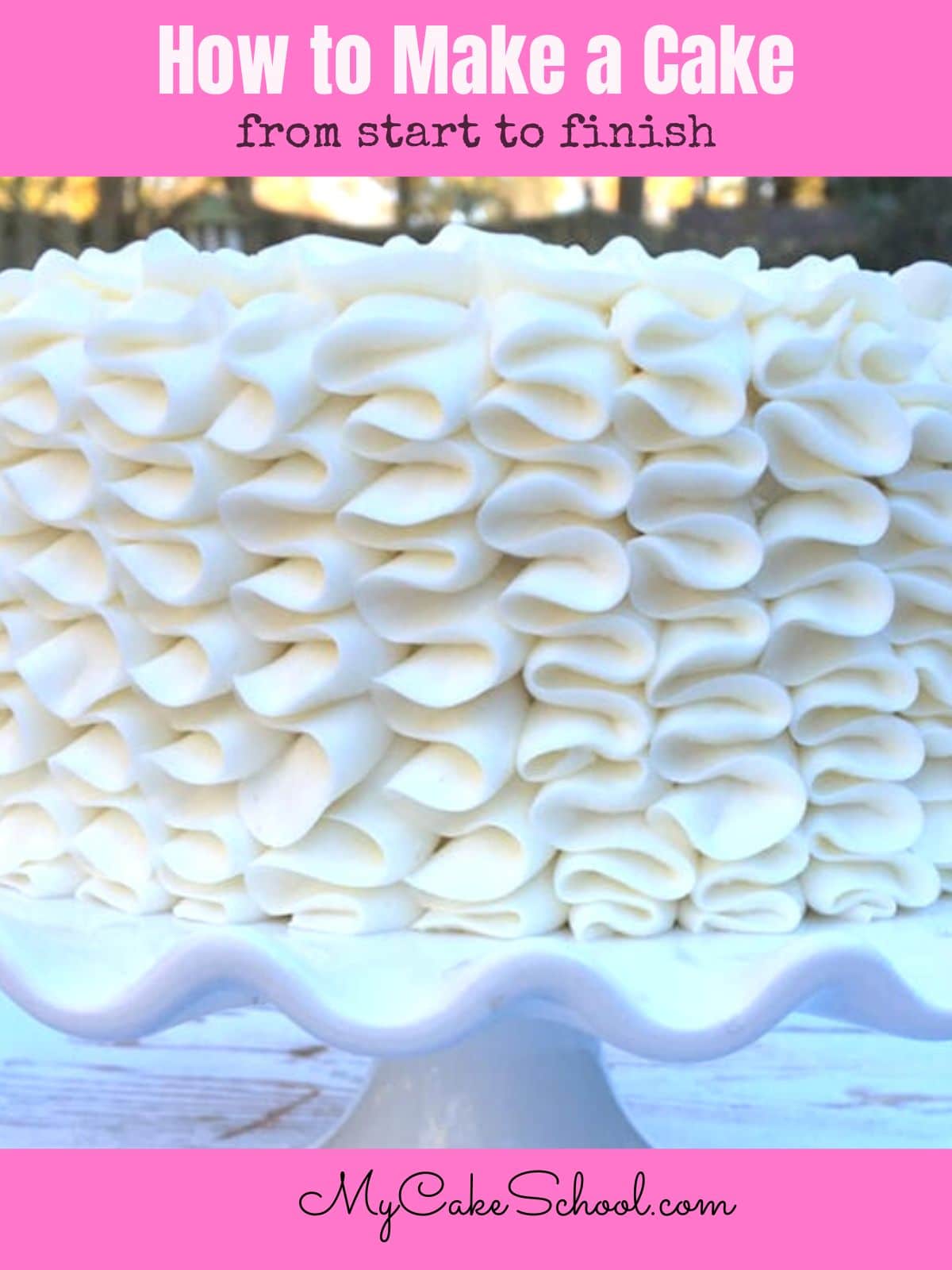How to Make a Cake
Today, I'm going to show you how to make a cake! If you are new to making or decorating cakes, this video is a great place to start.

Table of Contents
What You Will Learn
In this video, we'll show you how to successfully mix & bake a cake, how to wrap and freeze cake layers, trim cake layers, & settle the cake.
Then, I'll show you how to apply the crumb coat & pipe a simple ruffled buttercream design.
We'll show you key baking and cake decorating tips and tricks that will help you to become a better baker and cake decorator!
You can apply most of these methods to any cake that you are preparing. Have fun experimenting!
Part One: Mix, Bake, Freeze
Part Two: Settle, Crumb Coat, Decorate
Materials: How to Make a Cake
We used this White Almond Sour Cream Cake Recipe (which uses the conventional creaming method)
Buttercream (our classic vanilla buttercream and fluffy vanilla buttercream are both good options)
Cake Pans (Today, we used two 8 inch cake pans)
Digital Scale (optional but helpful)
Wilton 104 piping tip
Cardboard cake circle
Recipe FAQs
Thanks for Stopping By!
Thanks so much for stopping by, we hope that you enjoyed the video! Now that you know how to make a cake, we hope you'll have fun experimenting with different recipes, cake designs, and more!
Don't miss our huge collection of hundreds of cake recipes and free cake decorating tutorials! You'll find everything from birthday cake recipes to birthday cake design ideas, baby shower cakes, and more.
We have lots of cake recipes from scratch as well as cake mix recipes!
Some of our most popular cake recipes are White Velvet Cake, Carrot Cake, Lemon Cake, and Strawberry Cake!

Hi Ethel Ann, Yes, the recipe does have 1 teaspoon of almond extract. It is listed in the recipe is in the recipe section, but was left out of the above recipe link, I'll make that correction. I am not a fan of almond flavoring that must be why I left it off as you would do if you wanted a vanilla cake. I am sorry about that, thank you for letting us know
Loved this and learned many new points I'll put into practice!!
Thanks for making your post, Janis !
I am having a real problem with my cakes sinking in the middle. I researched this and found that opening the oven door can cause this and over mixing can do this so I make sure that I don't do either. I am baking the WASC into 8" and 6" pans at 350. I am not doing the reverse creaming method. I would really appreciate any help. I don't know how to fix this. It also happens with the chocolate recipe. ???
Hi Terri, Well, I am sure this is so frustrating for you! Have you checked your oven temperature? I think you might need to buy an oven thermometer to see if you oven is actually heating to the temperature you have set. Let us know how it goes.
Hi Bebe, thanks for your response. I do have an oven thermometer and my temp is 350. I baked 2 8" and 2 6" cakes. All 4 sank in the middle. It happens most of the time. My cakes never done. The cake mixes aren't expired. Do you think I should just use flower nails? Bake at a lower temp? The cakes look fine till they are almost ready to come out then they sink. Errrrr! I end up with half to 2/3s of a pan once I level.
Hi Terri, OK, that is good, it is not the oven temperature. I thought your cakes were sinking after being taken from the oven. Sinking while still baking and almost done is not as typical a problem. I did some research and the most common reason for the cake to sink in the center during baking is too much flour. You are baking the WASC using a cake mix, right? When I measure the flour I lightly spoon the flour into the cup then level it off using the back of a knife. If you dip the measuring cup into the flour container and scoop out the flour you will be packing more flour into the cup than needed. Do you think that could be the issue? Another reason is not enough liquid to the amount of dry ingredients in the recipe but I thought since you are using a cake mix, this is probably not the cause. Let me know.
Thanks a lot .I have learned a lot of new things and I will put it in practice.
After reading this article, I could not stop to myself from making it. So i prepared it. It was too yummy!!!!
Thanking You!!!!!
I have literally no room in my freezer Any other method i can use for a moist cake?
I'm so amazing at what I saw on your blog,was searching for a nice site where i can bake a cake when i came across your blog. Your steps areeasy and simple to understandable.
Thanks for creating this site.
Hie Melissa I can't get access to the videos Fr making the cake from scratch and the strawberry cake